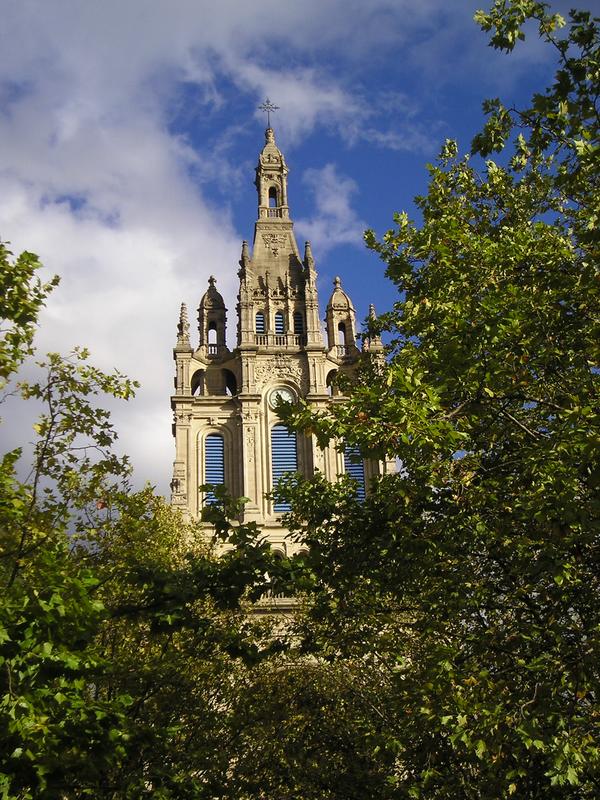- Basilica of Begoña
Infobox religious building
building_name=Basilica of Begoña
caption=Steeple of the basilica.
location=Flagicon|ESPBilbao ,Spain
geo=
religious_affiliation=Roman Catholic
province=Biscay
district=Begoña
consecration_year=16th century AD
status=Parish
leadership=
website=
architect=
architecture_type=Basilica
architecture_style=Gothic and Baroque
facade_direction=West
year_completed=
construction_cost=
capacity=
length=
width=
width_nave=
height_max=
dome_quantity=
dome_height_outer=
dome_height_inner=
dome_dia_outer=
dome_dia_inner=
minaret_quantity=
minaret_height=
spire_quantity=1
spire_height=
materials=limestoneThe Basilica of Begoña (or Basílica de Nuestra Señora de Begoña in Spanish) is abasilica inBilbao ,Spain dedicated to the patron saint ofBiscay , theVirgin Begoña .The current parish
priest is Jesús Francisco de Garitaonandia.History
The basilica started life in the 16th century, designed by
Sancho Martínez de Arego . It has threenave s, to which the addition of vaults was completed in the 17th century in construction work that took a century, having started in 1511. During the time of this work, the Gothic style developed somewhat, with the main entrance being built in the middle of the 16th century in the shape of a magnificent arch as a reminder of the works of Spanish architectGil de Hontañón . The rest of the building retains theunitarian Gothic style.During the 19th century, the basilica was damaged as a result of it forming part of Bilbao's
city wall . The Carlist GeneralTomás de Zumalacárregui was fatally injured near the basilica. The current tower and part of the exterior were designed by José María Basterra and built between 1902 and 1907.On16 August 1942 , a bomb was placed by one of the basilica's doors, supposedly by falangists targeting carlists, with several being injured. Juan José Domínguez, a well-known falangist, was shot as a punishment, although some still dispute his participation in the bombing.Work was carried out to correct the damage, however, and from September 1993 to June 1994, extensive cleaning and restoration work was carried out on the stone and the clock face and bells were repaired. The clock tower houses 24 bells, with the heaviest weighing a tonne, and were built in
Sumiswald ,Switzerland . The history of the clock tower dates back to 1922, and currently, seven different melodies can be produced.La Salve and the basilica
The "
La Salve " (Spanish for "salute" or "pray to the Virgin Mary") quarter of Bilbao is so named because it is the first point wheresailor s returning up the riverNervión , which passes through the city, were able to see the basilica's steeple. As a result, they would start to pray to the Virgin Begoña here, thanking her for having looked after them during their time at sea.Festivities and celebrations
The major festivals take place every
15 August (Assumption of Mary ), and11 October , the saint day of Begoña. Midnight mass is celebrated on these occasions, withpilgrimages taking place as locals and visitors go to worship.According to the basilica's [http://www.basilicadebegona.com/resena.htm website] , many sailors still remember the significance of the building, with "Virgen de Begoña" or "Begoña" being popular names among fleets.
The basilica is open to the public from Monday to Friday, 9:30am to 1:30pm and 4:30pm to 8:30pm.
External links
* [http://www.basilicadebegona.com/index2.htm Basilica website] (best viewed in Spanish or Basque)
Wikimedia Foundation. 2010.
